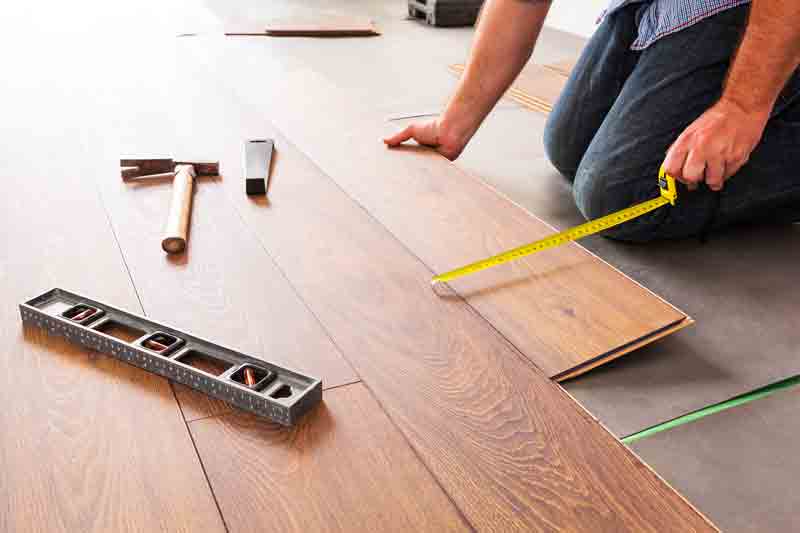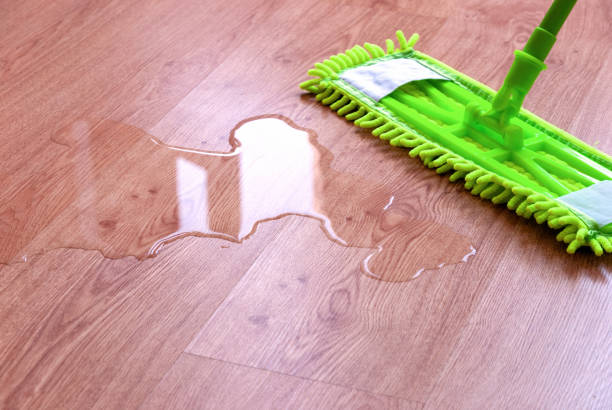When it comes to renovating your basement, choosing the right flooring is crucial. Among the many options available, waterproof laminate flooring for the basement stands out due to its practical features and aesthetic appeal.
This flooring type not only withstands the dampness typically associated with basements but also adds an appealing touch to your space.
Whether you’re turning your basement into a playroom, a home gym, or a home theater, waterproof laminate flooring for the basement ensures durability while maintaining a stylish appearance.
Benefits of Waterproof Laminate Flooring for Basements
Durability
Waterproof laminate flooring for basements is built to last. Its robust construction effectively resists wear and tear, proving its durability even in high-traffic areas of your home. This type of flooring is specifically designed to withstand the challenges of a basement environment, including moisture and temperature fluctuations.
Additionally, it stands up against scratches, stains, and dents, retaining its aesthetic allure over time. This makes waterproof laminate flooring for basements a cost-effective solution because you won’t need to replace it frequently.
Its long lifespan ensures that your basement maintains a fresh and stylish look for years to come.
Water Resistance
One of the most notable advantages of waterproof laminate flooring for basements is its exceptional water resistance. Basements are prone to moisture due to their below-ground location, making them susceptible to the adverse effects of water damage, such as mold and mildew.
However, this flooring repels water effectively, reducing the risk of damage caused by moisture. Its design includes a protective layer that shields the material from water seepage, thereby preventing warping, rot, and the growth of harmful mold.
This feature assures the integrity of your basement flooring and contributes to a healthier living environment.
Aesthetics
Waterproof laminate flooring for basements is not just about function; it also brings significant aesthetic appeal. Despite its practicality and durability, this type of flooring does not compromise on style.
Available in a wide array of designs, colors, and textures, waterproof laminate flooring can mimic the look of natural hardwood, stone, or ceramic tile, allowing homeowners to customize their basement to reflect their personal style and home decor.
The high-resolution photographic layer can realistically reproduce the appearance of these natural materials, adding a touch of elegance and sophistication to your basement.
Maintenance
Maintaining waterproof laminate flooring for basements is relatively straightforward and hassle-free. The durability and water resistance of this flooring type minimizes the need for rigorous and frequent cleaning.
Routine sweeping or vacuuming can help remove dirt and grit that may scratch the surface. For deeper cleaning, a damp mop or a cleaner specifically designed for laminate floors can be used.
It’s important to avoid using excess water or abrasive cleaners as these could potentially damage the floor over time.
Types of Waterproof Laminate Flooring

There are several distinct types of waterproof laminate flooring suitable for basements, each with its own set of advantages.
1. Luxury Vinyl Laminate Flooring
Luxury Vinyl Laminate Flooring is a popular choice for basements due to its extraordinary durability and water resistance.
Constructed with multiple layers, including a waterproof core, it can withstand high traffic, heavy furniture, and damp conditions without losing its aesthetic appeal. It is available in a wide range of designs and textures, mimicking natural materials such as wood and stone.
2. WPC (Wood Plastic Composite) Laminate Flooring
WPC Laminate Flooring combines the waterproof properties of vinyl with the rigidity and strength of wood. It has a thick and stable core made from wood pulp and plastic composites, offering excellent resistance to water and humidity.
This flooring type is particularly suited for basements because of its insulating properties, reducing cold and dampness from the concrete subfloor.
3. SPC (Stone Plastic Composite) Laminate Flooring
SPC Laminate Flooring is similar to WPC, but it uses stone dust in its composite mixture, making it even more rigid and stable. Its waterproof qualities, coupled with its ability to mimic a range of natural stone finishes, make it an excellent choice for basements that double as entertainment or living areas.
4. Tile Effect Laminate Flooring
Tile Effect Laminate Flooring brings the beauty of ceramic or stone tiles to your basement without the inherent fragility or coldness underfoot. It’s ideal for basements requiring a durable, waterproof, and easy-to-clean floor with the handsome appearance of tile.
5. Direct Pressure Laminate (DPL)
Direct Pressure Laminate is the most common type of waterproof laminate flooring. It’s made by directly applying melamine resins to a fiberboard core, resulting in an extremely durable and water-resistant surface.
This type of flooring is great for high-traffic basements, as it resists wear and tear remarkably well.
Each of these waterproof laminate flooring options offers an ideal solution for basement installations, providing both practicality and style.
Installation Process

Preparation required
Before you begin the installation of waterproof laminate flooring in your basement, it’s crucial to prepare the space adequately. Start by removing any existing flooring and check for signs of moisture or mold; these may indicate underlying issues that require addressing before installation.
The concrete subfloor should be flat, clean, and dry, free of debris and dust. Any cracks or uneven surfaces need to be filled and leveled to ensure a smooth installation.
Apply a moisture barrier to further protect your flooring from potential dampness inherent in basements.
Steps for Installation
Measure Your Space:
First, calculate the square footage of your basement to determine how much flooring you’ll need. Do this by multiplying the room’s length by its width. Remember to add 10% to account for any mistakes or damaged pieces.
Acclimate the Flooring:
Unpackage the laminate flooring and let it sit in your basement for about 48 hours. This allows the flooring to acclimate to the basement’s temperature and humidity levels and reduces the risk of warping after installation.
Install the Underlayment:
Roll out the underlayment across the entire basement floor, ensuring it lays flat and covers the entire area. The underlayment acts as a moisture barrier and provides a smooth surface for the laminate.
Start the First Row:
Begin at the longest wall of your basement. Place the first board in the corner, leaving a 1/4-inch gap between the wall and the laminate for expansion. The tongue side of the laminate should face the wall.
Continue with the Next Rows:
Connect the short end of the next board in the first row to the first board. Continue this process until the first row is complete. Start the next row, making sure the joints from adjacent rows aren’t aligned. This staggering of the joints will give a more natural wood floor look.
Cutting the Laminate:
Measure and mark the laminate for cuts. Use a circular saw or a laminate cutter to make the cuts. Remember to wear safety gear while doing this step.
Finish the Install:
Continue laying the flooring row by row. Use a pull bar to install the last row, as it will be too tight to use your hands. Ensure all pieces are secure and flat.
Post-Installation Care
Once your waterproof laminate flooring is successfully installed in your basement, it’s essential to maintain its aesthetic and functional quality. Here are some post-installation care tips:
Regular Cleaning:
Use a dust mop or vacuum cleaner to remove dirt and dust. Ensure that the vacuum cleaner is set to ‘hard floor’ mode to prevent damage to the laminate.
Spot Cleaning:
If you notice any spills or stains, clean them promptly with a damp cloth and a mild cleaner. Avoid using excessive water as it can seep into the edges and cause damage.
Avoid Scratches:
Place felt pads under furniture legs to prevent scratches. For heavy furniture and appliances, consider using a dolly during movement to protect the floor.
No Wax or Polish:
Unlike hardwood, laminate flooring doesn’t require waxing or polishing. These substances can leave a film and cause a dull appearance.
Climate Control:
Even though it’s a basement, try maintaining a stable indoor climate. Extreme changes in temperature and humidity can cause the laminate to expand and contract, leading to damage over time.
Related Topics:
Cost and Affordability
The cost of waterproof laminate flooring can vary widely depending on the brand, quality, and design. On average, prices can range from $2 to $5 per square foot for basic waterproof laminate, while high-end variants may cost up to $10 per square foot.
This price excludes installation costs, which can range from $1 to $3 per square foot depending on your location and the complexity of the job.
Comparison with Other Types of Flooring
When compared to other types of flooring, waterproof laminate flooring is a cost-effective alternative. For example, traditional hardwood flooring can cost between $5 to $15 per square foot, not including installation.
Additionally, hardwood requires more maintenance and is not suitable for moisture-prone areas like basements.
Tile flooring, on the other hand, is highly durable and water-resistant but comes with a higher price tag, ranging from $5 to $10 per square foot excluding installation.
It also tends to feel cold underfoot and may not offer the warm aesthetic that laminate flooring provides.
Carpeting can be a cheaper option, with prices as low as $1 per square foot, but it is highly susceptible to water damage and mold growth, making it a less ideal choice for basements.
Overall, waterproof laminate flooring offers a balance of affordability, durability, and aesthetic appeal, making it a compelling choice for basement installations.
Conclusion
In conclusion, waterproof laminate flooring for basements offers an exceptional balance of cost-effectiveness, durability, and pleasing aesthetics. It stands up to the unique challenges basements present, including dampness and temperature fluctuations, while offering a stylish appearance to complement any decor.
Its long lifespan and easy maintenance make it a practical, value-for-money investment for any homeowner. Given its superior water resistance, aesthetic versatility, and affordability compared to other flooring options, waterproof laminate flooring is undoubtedly a compelling choice for basement installations.
Whether you’re transforming your basement into an entertainment hub, a home gym, or a cozy family room, opting for waterproof laminate flooring ensures a blend of functionality, style, and comfort for years to come.
FAQs
What is the lifespan of waterproof laminate flooring in basements?
With proper care and maintenance, waterproof laminate flooring can last up to 15-25 years in a basement setting. Its lifespan largely depends on the quality of the product, frequency of use, and prompt cleaning of spills.
How does waterproof laminate flooring respond to temperature changes in basements?
Waterproof laminate flooring handles temperature fluctuations well as it is designed to resist expanding and contracting. However, in extreme temperature changes, there may be slight movement, which is normal and does not affect the durability or functionality of the flooring.

1 thought on “Waterproof Laminate Flooring For Basement: Laminate Luxury Below Ground”